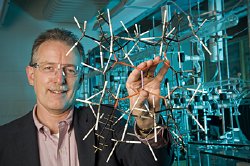Nov 23 2007
Chemists from the University of Delaware, in collaboration with a colleague at the University of Wisconsin, have set a new world record for the shortest chemical bond ever recorded between two metals, in this case, two atoms of chromium.
The distance? A minuscule 1.803 Ångstroms, which is on the order of a billionth of the thickness of a human hair.
The chemists weren't driven by the Guinness Book of World Records or even a friendly bet. As is often the case in science, they discovered the molecule, which has a quintuple (i. e., five-fold) bond, quite by accident.
 Klaus Theopold, professor and chairperson of the UD Department of Chemistry and Biochemistry
Klaus Theopold, professor and chairperson of the UD Department of Chemistry and Biochemistry
“Sometimes things like this just happen,” said Klaus Theopold, professor and chairperson of the UD Department of Chemistry and Biochemistry.
Theopold and Kevin Kreisel, who graduated with his doctorate from UD in August and is now a postdoctoral researcher at the University of Wisconsin, made the finding, working with research associate Glenn Yap and postdoctoral fellow Olga Dmitrenko, both from UD, and Clark Landis, a colleague from the University of Wisconsin.
The research was reported in the Journal of the American Chemical Society.
Theopold has been researching the chemistry of chromium for a long time. The metal is an important industrial catalyst for making plastics such as polyethylene.
“We discovered this interesting looking molecule and realized that it had an extremely short distance between the metal atoms,” Theopold said.
Using an analytical technique called X-ray diffraction, the scientists were able to look directly at the atomic structure of the new molecule and measure the distance between the chromium atoms.
A rule-of-thumb in chemistry, Theopold said, is that bond length and bond strength go together, so it's likely that the metal-metal bond is a strong one, although Theopold said no one knows for sure.
“This molecule is probably not practically useful. We're not going to get a patent here or cure cancer,” Theopold noted. “Records define the range in which things can exist. It's just an interesting molecule from a fundamental scientific standpoint.”
And those teeny-tiny bonds do mark a new world record for chemistry.
Before the UD discovery, Theopold said, the last record, achieved by researchers at Texas A&M University, stood for nearly 30 years.